Jacquard patterns — is one of the most interesting and creative trends in handicrafts. These complex and sophisticated patterns, created with the help of special techniques, allow you to create a unique atmosphere of knitted products with knitting needles.
Brief description of the technique
Jacquard knitting technique differs from regular knitting in its simplicity of execution and the ability to create many different patterns and designs. It allows you to use several colors of thread at the same time, which makes knitted items brighter and more original.

The peculiarity of jacquard is that each row has to be knitted in such a way as to obtain the desired pattern or design. This requires a certain precision and accuracy when performing the work.
Jacquard knitting begins with choosing a suitable pattern chart. The chart is a graphic representation of a design in which each square corresponds to one stitch. When making a pattern, the image is filled with multi-colored squares, indicating different colors of threads.
Knitting in the jacquard technique can be complex and requires certain skills from the knitter. Firstly, it is necessary to be able to stop after each color row and not get tangled in the threads. It is also important to be able to change the threads correctly so that the pattern is clear and not blurry.
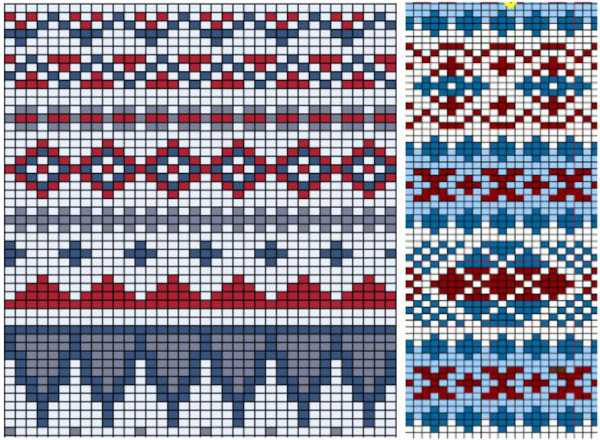
The "4 stitches" rule plays a special role in jacquard knitting. Its essence is that each color pattern is repeated after 4 stitches. That is, if the diagram says that the pattern is repeated after 10 rows, then in fact it will be repeated after 40 stitches.
Necessary tools and materials
When knitting jacquard patterns with knitting needles, special attention is paid to the choice of yarn and knitting needles. The main requirement for yarn for jacquard is its ability to hold its shape well and ensure the brightness and clarity of the pattern.
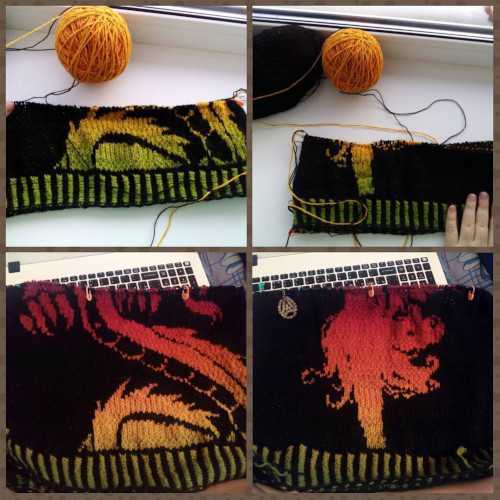
Jacquard knitting requires the use of 2 or more colours at a time, so the yarn must be well dyed and fade resistant.
A popular choice of yarn for knitting jacquard is wool or a wool-acrylic blend. Wool has unique properties such as insulation, softness, and elasticity, making it ideal for creating intricate patterns. Acrylic adds some durability and makes the product easier to care for.

For creating patterns that require the use of multiple colors, it is recommended to use knitting needles with plastic tips or special knitting needles with movable rings that allow you to quickly switch between colors.
You also need to consider the thickness of the yarn when choosing your needles. Thin needles are ideal for creating pattern details, while thicker needles allow you to move through the project faster and create larger patterns.
Master classes
There are many different types of jacquard patterns:
| Pattern name | Brief description |
| "crow's feet" | This pattern features a series of rectangles reminiscent of a houndstooth print. It is particularly effective when bright and contrasting colors are used. |
| "pigtail" | In this pattern, vertical "braids" of intersecting threads are stretched throughout the entire product. It is important to choose the right colors here to create a bright and expressive composition. |
| "geometry" | It is a combination of various geometric patterns: squares, triangles, circles, etc. Knitting such a pattern allows you to create genuine works of art. |
| "flora and fauna" | Here, patterns with various natural patterns are used: plants or animals. This option is especially popular for creating sweaters, hats and stoles. |
Scarf with deer pattern
For this master class, it is recommended to use knitting needles number 4 and yarn with a composition of 70% wool and 30% acrylic. For one scarf you will need about 300 g of yarn.
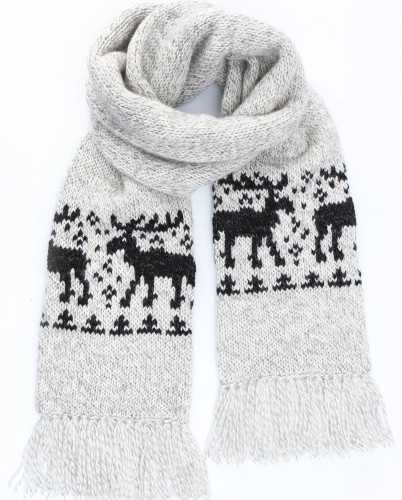
For this work you will need only the basic loops and loops with increase for the jacquard pattern with deer. The basic loops are made in straight ways: on the front side, knitting of loops is done with front seams, and on the back side - with back seams.
The number of stitches in a row depends on the width of the deer pattern and personal preference. It is recommended to add extra stitches to the edges of the scarf to get even edges.
To achieve the desired length of the scarf, a certain number of rows should be set based on the height of one row of the deer pattern. The length is usually about 180 cm.
Step by step process of knitting a scarf:
- Start by preparing your yarn and needles. Unroll the required amount of yarn and weigh it to make sure it is enough for the entire project. Set your needles to straight knitting.
- The next step is to create the base for the scarf. Cast on the required number of stitches. The frequency of the deer pattern determines the number of stitches you will need. It is recommended to add an additional 2-4 stitches for the edge of the scarf. The width of the deer in the pattern is 15 stitches, so you need to cast on 19 stitches.
- Start knitting with a jacquard pattern. It consists of 2 colors - the main and contrasting. Follow the pattern scheme, repeating the rows in accordance with the suggested sequence.
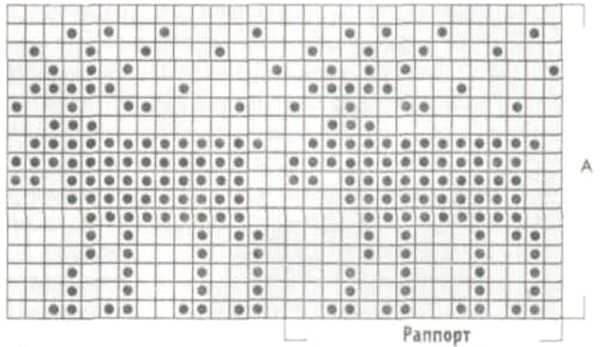
- When knitting, do not overtighten the loops so that the scarf is even. Pay attention to the knitting density so that the scarf is sufficiently dense and warm. You can change the knitting density by adjusting the tension of the threads.
- As you knit, follow the pattern diagram and after reaching the desired length, finish the work with the last row of the pattern.
- Finish knitting, carefully cut the yarn, leaving enough end for tying or tightening.
The knitting density is determined by the size of the yarn and needles. It is recommended to check it by comparing the product with the picture and making sure that the loops are not overtightened. If necessary, you can change the size of the needles or the size of the yarn. It is also recommended to adhere to the knitting density indicated on the yarn label so that the product turns out uniform and practical.
Autumn hat for women with a pattern "Chicken foot" in the technique of "lazy" jacquard
Jacquard patterns with knitting needles are suitable for knitting an autumn women's hat. For knitting, you will need a pair of knitting needles with a thickness in accordance with the selected yarn, as well as yarn, which should be a mixture of natural fibers, such as wool or cotton, with the addition of synthetic materials to increase strength and wear resistance.
To knit a hat you will need approximately 200-250 g of yarn or about 250-300 m.

The process of knitting a hat using the lazy jacquard technique with the chicken foot pattern continues with several simple steps:
- Start at the base of the hat by knitting the required number of stitches (usually about 100 stitches) on 1 needle. Knit the following rows in straight stockinette stitch to create a ribbing for a snug fit.
- Next, move on to creating the pattern. To do this, refer to the diagram, which shows that the "chicken foot" consists of a repeating pattern of 6 loops, which continues throughout the entire row. The "+" sign marks the front loops, "-" are the back loops. If the cell in the diagram is empty, this means the loop has been removed, and the working thread is located behind the work.
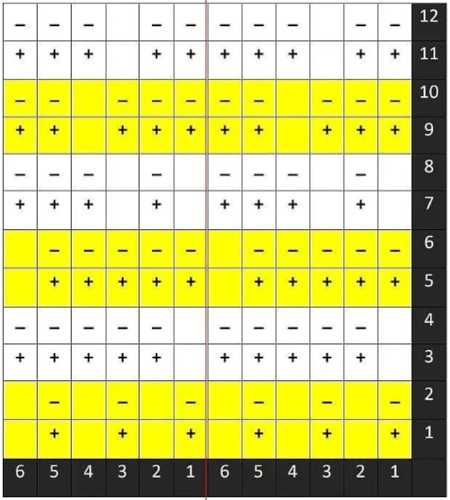
- Knitting of the pattern begins with the 2nd row. The number of loops in the row remains unchanged and equals 96 loops. In this row, every 6 loops are secured on a non-passing front loop with a "chicken foot" pattern. The remaining loops are knitted according to the pattern.
- Continue knitting the pattern according to the diagram, changing the front and back loops according to the "chicken foot" pattern. Repeat the pattern for the required number of rows.
- Once the hat has reached the desired height, move on to casting off the stitches. To do this, work the last row of plain knitting and gradually remove the stitches, knitting 2 adjacent stitches together every few stitches. When there are only a few stitches left, pass the yarn through them and tighten to secure the end of the hat.
The knitting density and final size of the hat will depend on the yarn chosen and the number of stitches in a row.
Children's mittens with snowflake pattern
Jacquard patterns with knitting needles will look spectacular on children's mittens. To knit them, you will need knitting needles with a thickness in accordance with the selected yarn. It is advisable to use knitting needles 15-20 cm long for ease of work.
It is best to use yarn made from natural fibers, such as wool or alpaca. The snowflake pattern on the mittens will look especially impressive if you use several colors of yarn.
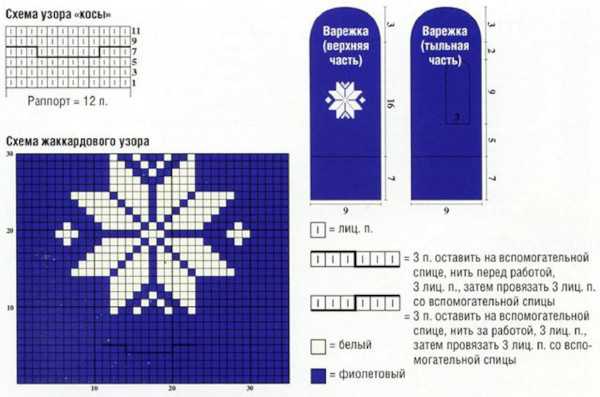
- The process of knitting mittens begins with creating a cuff. The required number of loops, usually about 40, are strung onto the knitting needles. Then several rows of 2x2 elastic are made, that is, 2 front loops, 2 back loops.
- After the cuff, we move on to the main part of the mittens. Knit with the front surface, except for the 29th row, which is knitted with the back. The number of loops in a row should be a multiple of 16, that is, 32 and 48. It should also be taken into account that in each row there should be 2 additional edge loops. To create a jacquard pattern, you should use the double knitting method. This means that a separate thread of yarn is required for each pattern row. The thread that is not involved in the pattern is placed behind the work.
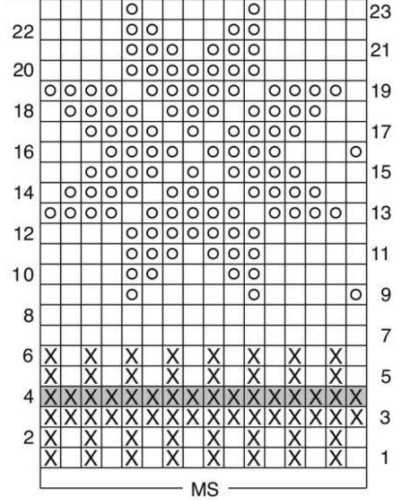
The different colors of yarn are marked with a cross, a black circle and a white circle on the diagram.
For example:
- the main yarn for mittens can be blue;
- snowflake (white circles on the diagram) – white;
- the pattern on the bottom of the product (loops marked with a cross) is blue;
- the top part of the pattern (black circles) is green.
- The pattern should be repeated until the desired height of the mittens.
- After completing the jacquard pattern, you should move on to creating the fingers of the mittens. In this case, only the loops that correspond to the fingers are knitted. The remaining loops remain on the needles.
- To finish the mittens, a circular elastic band is knitted with loops to close the top of the product. After closing the elastic band, all that remains is to carefully fix the ends of the threads and carry out the final processing.
When creating a jacquard pattern, you need to be careful and accurate when knitting the loops. Some loops have to be knitted twice to create individual elements of the pattern.
The neck, cuffs and bottom of the sweater are in a Latvian braid pattern
Jacquard patterns with knitting needles can be taken using the "Latvian braid", which is one of the popular ones, which is often used to decorate the neck, cuffs and the bottom of shoulder products.
To knit the Latvian braid pattern, you will need knitting needles, the thickness of which depends on the chosen yarn. It is worth noting that for this pattern it is best to use medium-density yarn made from natural fibers such as wool or cotton.

Mainly used are front and back loops, as well as loops connected with a shift. The number of loops in a row is also determined by the pattern and the size of the product. It is important to follow the number of rows indicated in the pattern so that the pattern is uniform and symmetrical.
The process of knitting the Latvian braid pattern consists of several steps:
- Determine the number of stitches required for a given pattern. This depends on the size of the item and the knitting density.
- To create a three-dimensional pattern, you need to cross the threads in front of all the loops without exception. But in the 1st row, this must be done in one direction, and in the 2nd - in the opposite direction. And continue alternating until the end of the pattern. You get a kind of three-dimensional "herringbone", which in its finished form resembles a braid. At the same time, this pattern has a pleasant bonus: the threads, if the knitting process is done correctly, do not get tangled, but will separate themselves in each subsequent row. To achieve this effect, place all the working threads in front of the work.
- Take the yarn of the main color and place it under the thread of the additional shade, knitting a purl loop. This way, the main thread will automatically be placed on top, above the additional one.
- Pass an additional thread under the main one, using the purl stitch of the loop.
- All actions indicated in points 2-4 are repeated until the end of the row, closing it into a circle.
- Move to the 2nd row.
- To get the 2nd part of the "Latvian braid", knit a loop with yarn of the same color on which the 1st row was finished. And the thread is crossed in the opposite direction to the previous row. It is necessary to remember that the yarn is always located in front of the work. In the 2nd row, the thread of the main color should be located on top of the additional one. When knitting, use purl loops.
- Knit the required number of rows to obtain a finished composition with the “Latvian braid” pattern.
You can place 2 patterns with "Latvian braid" on the edges of the cuff, and use a rib knit between them. For the neck and the bottom of the shoulder piece, you can alternate "Latvian braid" and rib several times.
In order for the knitted product to retain its shape and not be too loose or, on the contrary, tight, it is important to choose the right knitting density. To do this, you can knit a sample and check its dimensions.
If the product is too small, use thinner needles or add stitches to the row. If the product is too big, use thicker needles or decrease stitches to the row.
Socks with Norwegian pattern
Before you start working, you need to decide on the length of the socks and the size of the knitting needles. For knitting socks, it is recommended to use circular knitting needles with a diameter of 2.5 mm, as well as a set of circular knitting needles with a diameter of 3 mm for the elastic and relief pattern.
To create socks using the jacquard technique, you need to choose yarn with the following characteristics: composition 80% wool, 20% polyamide. Yarn length from 175 m, weight from 50 g. You will need 2 skeins of the main yarn and a small amount of yarn of a different color for the ornament.

The types of stitches used in knitting include knit stitches and purl stitches. For a knit stitch, the needle is inserted from left to right through the stitch on the right, and for a purl stitch, the needle is inserted from right to left through the stitch on the left.
The number of loops in a row may vary depending on the size of the sock. For a woman's sock, it is recommended to cast on 60-64 loops, and for a man's sock, 68-72 loops. The number of rows is determined depending on the desired length of the sock, on average, it is about 60-70 rows.
Knitting socks consists of the following steps:
- The process begins with creating an elastic band. Cast on 64 stitches on 3 mm diameter knitting needles and knit 8 rows of stocking stitch.
- Then switch to 2.5 mm diameter knitting needles and start knitting the jacquard pattern using the diagram. The pattern is also knitted with face loops.
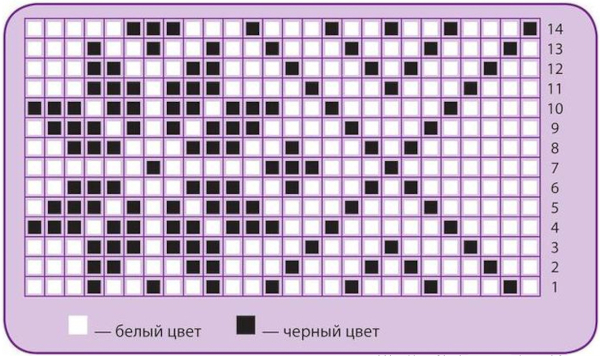
- At the heel, reduce the stitches to 33 to ensure the socks fit properly on the foot. For a square heel, the process must be started with a 2x2 elastic band. Use front and back stitches.
Cat paw socks
Jacquard patterns with knitting needles "cat's paws" are suitable for knitting socks. For this you will need knitting needles No. 2.5 and yarn consisting of 75% wool and 25% acrylic. For one pair of socks, about 100 g of yarn is enough, which is about 420 m.
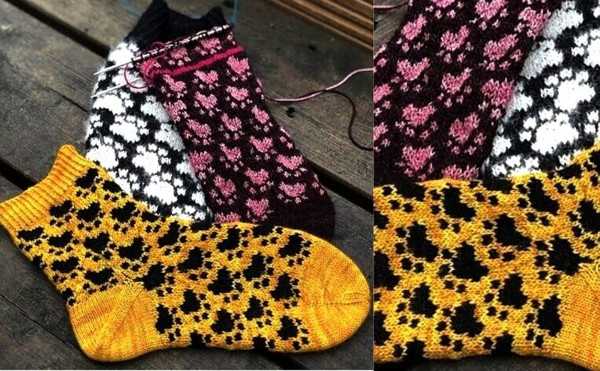
Knitting process:
- It starts with casting on stitches onto the knitting needles. To do this, cast on 32 stitches onto each knitting needle. The total number of stitches is 64.
- Knitting the main part of the sock. When using jacquard, follow the pattern where the symbols for knitting cat paws are indicated. This pattern uses the symbols "x" and a white cell, where "x" denotes an additional color of yarn, and the empty cell is the main one.

- The sock is knitted in a circle, starting with the elastic. The elastic is 2 front loops, 2 back loops in a repeating pattern. The elastic is 4 cm high, allowing for elasticity and a good fit on the foot.
- Next comes the main part of the sock, where knitting is done according to the pattern. When the length of the sock reaches about 15 cm from the elastic, you can start closing the loops. To do this, the loops are successively connected in pairs and pulled up with the help of the working thread. Then the working thread is sewn from the outside.
The knitting density for this model of socks is about 30 loops per 40 rows on an area of 10x10 cm.
It should be noted that knitting socks with a jacquard pattern "cat paws" requires some experience and attention. Therefore, before starting this project, it is recommended to gain some experience in knitting socks and knitting patterns in the jacquard technique.
Shawl with double-sided jacquard pattern "diamonds"
To knit such a shawl, you will need 3.5 mm long knitting needles and medium-thick yarn consisting of 50% wool and 50% acrylic. You will need to buy about 400 m or 150 g of such yarn.
The process of knitting a shawl using the double-sided jacquard technique:
- It starts with creating a base of loops on the knitting needles. You can knit with both circular and straight knitting needles. The number of loops in a row depends on the chosen size of the shawl. To begin with, it is recommended to cast on 100 loops on the knitting needles.
- After creating the base, the process of knitting the diamond patterns begins. The first row should be knitted with face loops. Then, on the 2nd row, knitting the diamond pattern begins using double-sided jacquard. In total, it is necessary to knit 9 rows according to the patterns given below:
- 1st row: 1 front loop, 1 back loop – repeat to the end of the row;
- 2nd row: 1 purl stitch, 1 front stitch – repeat to the end of the row;
- 3rd and 4th rows: knit according to pattern 1;

- 5th and 6th rows: knit according to pattern 2;

- 7th and 8th rows: knit according to pattern 3;

- Row 9: knit according to pattern 4.

- After knitting all 10 rows, the diamond pattern is repeated in reverse order. That is, starting from the 10th row (instead of it), you need to knit the 9th, then the 8th, and so on. The result is a double-sided pattern effect that looks great on a shawl.
- The number of rows in the entire shawl depends on the desired length of the product. It is recommended to knit about 200-300 rows to achieve an average length of the shawl. The knitting density can be selected depending on the desired effect: for denser knitting, you should choose thicker needles and add more loops to the base.
Tips for Beginners
When knitting jacquard patterns with knitting needles, a novice craftswoman should pay attention to several important points:
- First, before you start working, you need to decide on the yarn you will use. The jacquard pattern requires the use of several colors, so it is recommended to choose a yarn that is well suited for separating colors and provides a clear view of the pattern.
- Secondly, before starting work, you need to familiarize yourself with the pattern diagram and carefully study its repeating pattern. Jacquard patterns often have a complex structure and many different elements, so it is important to correctly understand and remember the order of their knitting.

- Thirdly, when knitting a jacquard pattern, it is important to ensure that the thread tension is correct. Uneven tension can lead to distortion of the pattern. It is recommended to check the tension frequently and, if necessary, adjust it by twisting the yarn.
- It is also important to consider the size and proportions of the pattern. It is recommended to test knit the pattern and check its compliance with the specified dimensions. If the pattern is too small or too large, you can make adjustments by changing the number of loops or the size of the needles.
Jacquard patterns are distinguished by their complexity and beauty. This technique allows you to create a variety of patterns and designs on knitted items. The peculiarity of knitting in this technique with knitting needles is the use of several colors of thread at the same time.
Video about jacquard patterns with knitting needles
Three-color jacquard pattern for beginners:
